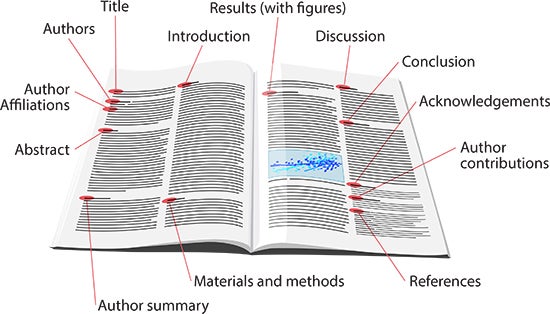The Library Catalog
Using the Full-Text filter will filter out any articles that you do not have full access to through the library. If you come across an article in the catalog that we do not have (this will only happen if you are not using "Full-Text" filter), you can request a copy of the article via InterLibrary Loan.

Peer review is a quality-control process used by publications to help ensure that only high-quality, methodologically sound information is presented in the publication. In the peer-review process material submitted for publication is sent to individuals who are experts on the topic. Those experts read the material and suggest to the editor whether the material should be rejected, should be accepted, or should be sent back to the authors with a request for revisions. Almost all peer-reviewed journals are scholarly journals.


Research papers generally follow a specific format. Here are the different parts of the scholarly article.
Abstract (Summary)
The abstract, generally written by the author(s) of the article, provides a concise summary of the whole article. Usually it highlights the focus, study results and conclusion(s) of the article.
Introduction (Why)
In this section, the authors introduce their topic, explain the purpose of the study, and present why it is important, unique or how it adds to existing knowledge in their field. Look for the author's hypothesis or thesis here.
Introduction - Literature Review (Who else)
Many scholarly articles include a summary of previous research or discussions published on this topic, called a "Literature Review". This section outlines what others have found and what questions still remain.
Methodology / Materials and Methods (How)
Find the details of how the study was performed in this section. There should be enough specifics so that you could repeat the study if you wanted.
Results (What happened)
This section includes the findings from the study. Look for the data and statistical results in the form of tables, charts, and graphs. Some papers include an analysis here.
Discussion / Analysis (What it means)
This section should tell you what the authors felt was significant about their results. The authors analyze their data and describe what they believe it means.
Conclusion (What was learned)
Here the authors offer their final thoughts and conclusions and may include: how the study addressed their hypothesis, how it contributes to the field, the strengths and weaknesses of the study, and recommendations for future research. Some papers combine the discussion and conclusion.
NCSU Libraries Interactive Tutorial
This interactive tutorial shares the various components of scholarly journal article, such as the title, author, abstract, introduction, publication information, charts and graphs, conclusion, and references. (Methods and Discussion sections are not explicitly called out and included in the Article Text section.)
 "Is my source scholarly" by Illinois Library https://www.library.illinois.edu/ugl/howdoi/scholarly/
"Is my source scholarly" by Illinois Library https://www.library.illinois.edu/ugl/howdoi/scholarly/
PsycARTICLES®, from the American Psychological Association (APA), is a definitive source of full text, peer-reviewed scholarly and scientific articles in psychology. It includes all journal articles, book reviews, letters to the editor, and errata from each journal. Coverage spans 1894 to the present and nearly all APA journals go back to Volume 1, Issue 1.
The PsycINFO®, database, American Psychological Association’s (APA) renowned resource for abstracts of scholarly journal articles, book chapters, books, and dissertations, is the largest resource devoted to peer-reviewed literature in behavioral science and mental health. Journal coverage, which spans from the 1800s to the present, includes international material selected from around 2,500 periodicals in dozens of languages.
PsycTESTS®, produced by the American Psychological Association (APA), serves as a repository for a growing selection of psychological tests and measures, including thousands of actual test instruments and test items that are available for immediate download and use in research and teaching. International in scope, PsycTESTS® also provides access to an increasing number of tests that are available in languages other than English.
A research article is a primary source, meaning that it reports on original research done by the authors of the article. Research articles normally include the following parts:
A review article is a secondary source, meaning that it discusses other articles and doesn't report original research. Review articles are a great way to get an overview of the research being done.
While you are Reading:
How to Take Notes on the Article
Try different ways, but use the one that fits you best. Below are some suggestions:
Reflect on what you have read - draw your own conclusions.
As you read jot down questions that come to mind. These may be answered later on in the article or you may have found something that the authors did not consider. Here are a few questions that might be helpful:
What are psychological tests?
Psychological tests (also known as mental measurements, psychological instruments, psychometric tests, inventories, rating scales) are standardized measures of particular psychological variable such as personality, intelligence, or emotional functioning. They often consist of a series of questions that subjects rank as true or false, or according to a Likert-type scale (agree, somewhat agree...), however tests can also use written, visual, or verbal methods.
Learn how to find, use, and cite Psychological Tests & Measures here.
